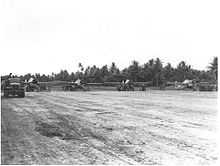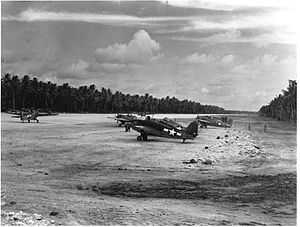Nanumea Airfield
Nanumea Airfield.svg.png) | |
|---|---|
| Part of Seventh Air Force | |
| Nanumea, Tuvalu | |
|
| |
| Coordinates | 05°41′00″S 176°07′44.4″E / 5.68333°S 176.129000°E |
| Type | Military Airfield |
| Site information | |
| Controlled by |
United States Army Air Forces United States Marine Corps |
| Condition | abandoned |
| Site history | |
| Built | 1943 |
| Built by | Seebees |
| In use | 1943-5 |
| Materials | Coral |
Nanumea Airfield is a former World War II airfield on the island of Nanumea in the Ellice Islands (now known as Tuvalu).
History
World War II
On 5 September 1943 elements of the 16th Naval Construction Battalion arrived on Nanumea and on 11 September they started work on a 7,000 feet (2,100 m) by 200 feet (61 m) bomber strip. On 19 September F4F-4s of VMF-441 landed on the strip and continued to use the runway during the remainder of the construction period. The first bombers landed on 12 November. The Seabees also built the camp and operation facilities for the airfield, including an 8,000-barrel tank farm for aviation gasoline.[1]
United States Army Air Forces (USAAF) units based at Nanumea included:[2]
- 30th Bombardment Group headquarters from 11 November 1943 - 4 January 1944
- 27th Bombardment Squadron operating B-24s from 10 November 1943 - 26 February 1944
- 28th Bombardment Squadron operating B-24s from 12 November 1943 - 13 March 1944
- 45th Fighter Squadron operating P-40Ns from 28 November 1943 - 4 January 1944
The Marine Attack Squadron 331 (VMA-331) flew Douglas SBD Dauntless dive bombers from Nanumea. Other United States Marine Corps (USMC) units based at Nanumea included:
- VMF-441 from 19 September - December 1943
On 11 November 1943 a Japanese air raid on Nanumea resulted in the destruction of one B-24.
On 19 November 1943 B-24 #42-72980 of the 27th Bombardment Squadron crashed on landing.
On 27 November 1943 SBD #38035 of VMSB-331 crashed due to undercarriage failure.
By September 1944 base roll-up and salvage operations had commenced and were completed by the end of March 1945.[1] Wreckage of the aircraft remained on the island.[3]

Postwar
After the Pacific War the airfield was dismantled and the land returned to its owners, however as the coral base was compacted to make the runway the land now provides poor ground for growing coconuts.[4]
See also
References
- ↑ 1.0 1.1 Building the Navy's Bases in World War II History of the Bureau of Yards and Docks and the Civil Engineer Corps 1940-1946. US Government Printing Office. 1947. p. 236.
- ↑ Maurer, Maxwell AFB (1983). Air Force Combat Units Of World War II. Alabama: Office of Air Force History. ISBN 0-89201-092-4.
- ↑ Bartsch, Bill. "War Relics in Tuvalu and Kiribati". South Pacific Bulletin (1975). Retrieved 7 April 2014.
- ↑ Melei Telavi, Hugh Laracy (ed.) (1983). "Chapter 18 - War". Tuvalu: A History. Institute of Pacific Studies, University of the South Pacific and Government of Tuvalu. p. 143.
